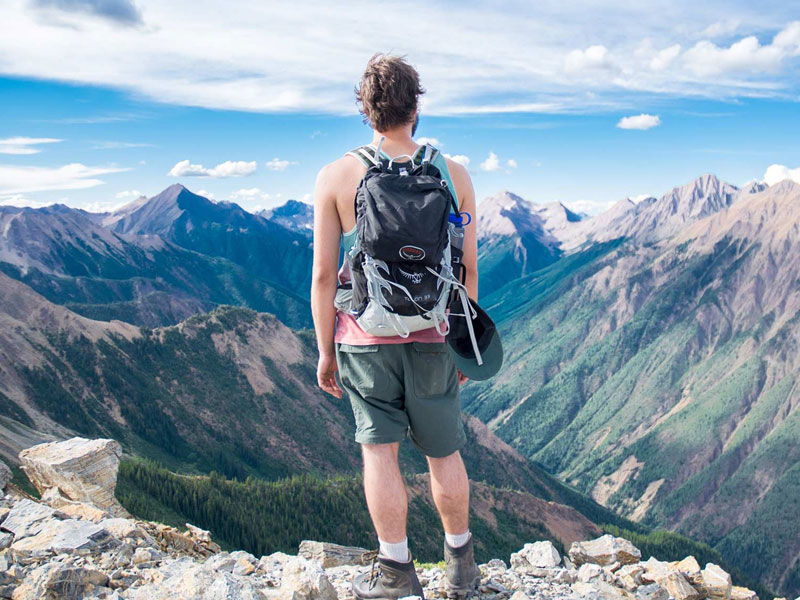
ALTITUDE TRAINING: What is it? How to do it?
Training at high altitude has a whole host of health and fitness benefits, and has been used extensively by competitive athletes as a means of improving their performance. In recent years, the vast majority of the elite endurance athletes utilize altitude training in their year round training as a means of reaching a higher performance level. The benefits of altitude training come to the body through natural procedures and mechanisms and for this reason is considered as a legal doping.
What is Altitude Training?
Altitude training, also known as hypoxic training, is defined as a procedure that involves exercising or living in oxygen reduced air, for the purpose of producing physical adaptations that can improve athletic performance and physical wellness. In order to provide the suitable hypoxic stimulus that can trigger the initiation of physical adaptations, athletes must expose their bodies at altitudes above a certain point and for a certain amount of time.
Today scientists have studied extensively the response of the body in high altitude environments and the training models that can be utilized for this cause. But before I present to you the outcome of this longitudinal research, let me explain how and when did this all started.
History of Altitude Training
Altitude training drew the attention of scientists and coaches for the first time at the 1968 Olympics. This Olympic Games took place in Mexico City, in Mexico at an elevation of 2,240m (7,349 ft.).This was the first major athletic event at high altitude. As it was hypothesized by most of the scientists just before this Olympic Games, all the endurance sports had significantly lower performances compared to sea level records. In addition to the theories around altitude environments and performance, although all the athletes had significant decrement on their performance, altitude born athletes dominated every race. At the same time anaerobic sprint athletes broke all types of records. This drew the attention of the scientific community and inspired research on altitude training which continues until today.
What is different at high altitude?
At high altitudes, the barometric pressure is reduced. To be more specific, mercury at sea level starts from 760mm and as we go higher is gradually reduced. Particularly, at 2250m in Mexico City the atmospheric pressure is at 75% of sea level and at the top of the Everest is less than one third.
This phenomenon of reduced barometric pressure is called hypoxia and characterizes the environment at high altitude. Moreover, due to the reduction of the barometric pressure, the partial pressure of oxygen, is also reduced. This gives the feeling of breathing in “thinner air”, which is why breathing at high altitudes is more difficult. In turn, there’s a reduced oxygenation of the blood, which leads to less oxygen being transported to and utilized by working muscles. This eventually causes the body to fatigue quicker.
As a consequence, these conditions lead to a reduced VO2max at high altitude in comparison with sea level VO2max.Specifically, it has been estimated that VO2max drops 10% every 1000m of elevation, from 1200m and above, so at the top of the Everest an average mountaineer has only 27% of his VO2max at sea level (West et al., 1983). This explains well, why we see mountaineers at the last steps to the summit of the Everest taking a break every two or three meters.
Altogether, the major difference of high altitude is the reduced partial pressure of oxygen and this is exactly why it affects in a different way the performance in anaerobic and aerobic sports.
How does High Altitude affect sports?
In anaerobic sports, where athletes don’t rely on oxygen for energy and must overcome the resistance of the air, it’s reasonable to expect significantly better performances at high altitude, mostly due to the reduced air resistance. The environment has less aerodynamic resistance and less gravitational pull.
This explains why we had so many records on this kind of sports at the 1968 Olympic games in Mexico City.
- 100 m: Jim Hines 9.95 sec
- 200 m: Tommie Smith 19.83 sec
- 400 m: Lee Evans 43.86 sec
- Long jump: Bob Beamon 8.90 m
On the contrary, in sports of longer duration where oxygen is essential we had a significant reduction of performance. As the distance and consequently the time of exercise get bigger, performance drops in comparison to sea level mostly due to the rising reliance on the aerobic energy system.
Nevertheless, although altitude affects differently aerobic and anaerobic sports, its key is that it gives the opportunity to gain adaptations that all kind of sports can benefit from.
In order to see how that can happen we need to understand how does the body respond to the hypoxic environment.
What are the benefits of Altitude Training?
As a result of the exposure to altitude conditions, the body responds acutely and chronically, with physiological alterations and adaptations. At the first hours at altitude the body responds acutely with:
- increased pulmonary ventilation (VE)
- increased heart rate (HR)
- reduced maximum heart rate (MHR)
- and finally a reduced VO2maxin comparison with sea level VO2max
As you understand, these acute responses are accompanied by an acute reduction of performance which lasts until the suitable adaptations occur. These adaptations are the chronic response of the body to the altitude environment. This process is called acclimatization and starts from the moment you set foot on altitude. It starts with the rise of erythropoietin (EPO) in the serum. Erythropoietin is the hormone responsible for the reproduction of red blood cells. Erythropoietin stimulates erythropoiesis, the process of red blood cell production in the bone marrow, which leads to:
- increased hemoglobin concentrations in blood (Hb)
- increased red blood cells (RBC)
- and consequently, elevated hematocrit (Hct).
These adaptations eventually lead to more oxygen being transported to and utilized by working muscles. As a result of the aforementioned hematological adaptations, athletes enhance their aerobic capacity. Even more, studies have shown many non-hematological adaptations that occur during altitude training and play a vital role in sports performance. In particular, they found that altitude training programs can:
- increase capillary density
- increase number of mitochondria and oxidative enzymes.
- increase buffering capacity
- and improve exercise economy
The combination of all these adaptations leads to two significant reasons why someone would want to take advantage of this training method. The first one is to perform better at high altitude and the second one is to perform better at sea level.
The first one is quite obvious. In order to be able to perform your best at altitudes, you need to adapt to the conditions of the environment.
The second suggests that athletes can use the adaptation that gained at high altitude in order to perform better at sea level. Although this idea is still under debate, from my scan of the literature I think it’s fair to say that for most of the athletes this is possible. With that in mind, the actual question that rises is how can you do that?
Altitude Training Models
Throughout the years, research and practice led Scientists and Coaches to some specific training models that can be used for the cause of improving performance.
These are the:
- Live High Train High (LHTH)
- Live High Train Low (LHTL)
- Intermittent Hypoxic Exposure (IHE)
- Intermittent Hypoxic Training (IHT)
The Live High – Train High (LHTH)model.
This was the first altitude training model. In this regime, an athlete lives and trains at a desired altitude. The stimulus on the body is constant because the athlete is continuously in a hypoxic environment. Traditional altitude camps consist of living and training at a moderate altitude of 1800–2500 m, usually for 4 weeks. On return to sea level after an altitude training camp sea level performance is expected to be improved due to the physiological adaptations that have been produced at altitude.
Despite the debate that carries on until today, LHTH model is in most of the cases an effective regime for producing hematological adaptations and improving both high altitude and sea level performance.
The problem that scientists found while applying this model is that as hypoxia increases the ability of the athlete to perform a quality training decreases. This can lead to performance decrements in elite athletes! Athletes are no longer able to metabolize as much oxygen as they would at sea level and any given velocity must be performed at a higher relative intensity. The answer to that problem was the Live High – Train Low (LHTL) model, or in other words, the Sleeping High Training Low (SHTL) model.
The Live High – Train Low (LHTL) model.
This training idea involves living or sleeping at higher altitudes in order to experience the physiological adaptations that occur, while maintaining the same exercise intensity during training at sea level. Hence, the beneficial effects of altitude exposure are harnessed whilst some of the negative ones are avoided.
The Live High – Train Low model is considered to be the most effective strategy for improving both sea level and high altitude performance. In particular, there has been a ton of studies supporting its efficiency in producing both hematological and muscular adaptations when used in the right way (Wilber 2004, Wehrlin 2006, Schmitt 2006, Brugniaux 2005, Hinckson 2005, Denhert 2002, Levine 1997, Stray-Gandersen 2001, Gore 2001, Levine 2001, Garvican 2001, Saundres 2009, Robertson 2010, Hahn 2001).
However, this method placed a large amount of stress and fatigue on the athletes due to the constant ascending and descending into altitude, travelling to and back from training sites and its high financial costs. The development of new devices made it possible to use artificial altitude as an additional training stimulus without travelling to the mountains
This is what we call ‘Altitude Simulation’. In order to do that, scientists create normobaric hypoxia via nitrogen dilution or oxygen extraction. The most common techniques are the hypobaric chambers that simulate the barometric pressure and the hypoxicators, which are generators that provide the suitable gas mixture into masks, chambers and hypoxic sleeping units. Due to the technical difficulty of transporting to higher altitudes every day, most of the athletes on LHTL model utilize artificial altitude.
The Intermittent Hypoxic Exposure (IHE) model.
Intermittent hypoxic exposure (IHE) or periodic exposure to hypoxia is defined as an exposure to hypoxia lasting from seconds to hours that is repeated over several days to weeks. These intermittent hypoxic bouts are separated by a return to normoxia or lower levels of hypoxia
Although it sounds promising, in the majority of the studies with control groups, IHE didn’t induce any substantial change in either hematological parameters or in endurance performance (Abellan et al. 2005, Ricart et al. 2000, Frey et al. 2000, Rodriguez et al. 2003, Julian et al. 2004, Tadibi et al. 2007, Lundby et al. 2004). This might be due to the small dose of the altitude stimulus.
Nevertheless, IHE might have the potential to produce some of the physiological adaptations that occur at altitude but the conditions under which a change like this can happened need further investigation.
The Intermittent Hypoxic Training (IHT) model.
The last model is the Intermittent Hypoxic Training (IHT), were athletes can train under hypoxic conditions and remain at sea level for the rest of the time.
As a result of the small altitude dose it is clear that Intermittent Hypoxic Training alone cannot produce hematological adaptations like the ones we can expect on the LHTH and the LHTL models. This was evidenced by the studies of Vallier et al. 1996, Trouijens et al. 2003, Emonson et al. 1997 and Terrados et al. 1988, which all showed no significant changes in hematological variables after IHT protocols.
However, when it was combined with Intermittent Hypoxic Exposure, Intermittent Hypoxic Training was more effective on improving hematological parameters. Rodriguez et al. in 1999 and Casas et al. in 2000, used a combination of IHE with IHT and found significant hematological adaptations. Both of these studies concluded that short-term hypobaric hypoxia combined with low-intensity training can produce improvement in the blood oxygen transport capacity.
On the other hand, Intermittent Hypoxic Training alone has shown significant muscular adaptations that could increase performance. The study of Terrados and co-workers in 1990 is one of the first to have investigated the effects of hypoxic training on muscle tissue in man. The protocol consisted of training one leg in normoxia and the other one in hypoxia corresponding to 2300 m, for 30 minutes 3–4 times a week. Analysis of the muscular biopsies revealed a greater increase of citrate synthase activity under hypobaric conditions than under normobaric conditions. In addition, the myoglobin content increased in the leg trained under hypobaric conditions, whereas it tended to decrease in the normobarically trained leg.
More recent studies of Vogt et al. 2001 and Geiser et al. 2001 have found enhancement of capillary length density after Intermittent Hypoxic Training only, as well as a greater increase in mitochondrial volume density. Interestingly, the greatest increases in both these parameters were observed in the group that trained at higher intensity.
Together, these results demonstrate that Intermittent Hypoxic Training leads to muscular adaptations that either do not occur in normoxic conditions, or if they do so, they do to a lesser degree.
The actual question is if these adaptations can improve performance. As always, the findings are controversial but most of the studies have found significant improvements on performance after IHT protocol (Vallier et al. 1996, Terrados et al. 1988, Geiser et al. 2001, Roels et al. 2006, Ramos-Campo et al. 2016, Meeuwsen et al. 2001, Dufour et al. 2006, Hamlin et al. 2003, Faiss et al. 2013 and Czuba et al. 2013).
How to train at High Altitude?
How to train on a Live High – Train High (LHTH) model.
Traditional LHTH camps consist of living and training at moderate altitude of 1800–2500 m, usually for 4 to 5 weeks. These camps usually consist of 4 progressive phases:
- At first, we have the acclimatization phase, were athletes have the time to acclimatize on the low Partial pressure of O2, while training at low intensity. This usually takes 7 to 10 days.
- Next is the primary training phase. In this phase athletes can progressively increase training volumes up to levels similar to those at sea level. It is recommended to stay on that regime for 2 to 3 weeks.
- Then there is the recovery and preparation for return to sea-level phase. This is a small period of 2 to 5 days at the end of the camp. The aim of this phase is to recover completely from the altitude-induced fatigue with less training volume and intensity.
- Finally, we have the return to sea level.
How to train on a Live High – Train Low (LHTL) model.
In order to have a successful altitude training block with Live High Train Low regime, you need to be very careful with the altitude dose that you will be exposed to. The altitude dose refers mainly to three different aspects of the total stimulus that you want to give to your body. These are the elevation that you will be “living”, the elevation that you will be training and the amount of time that you will stay on that regime.
So the first question is, how high to live during Live High Train Low?
In general, the higher an athlete lives, the greater the production of erythropoietin(EPO) is. However, there appears to be both a minimum altitude threshold for red cell production, as well as a ceiling, above which adaptation and performance may ultimately be impaired.
In a well-controlled research study, a group of athletes completed 28 days of “high-low” altitude training, in which the groups were divided into four different living altitudes: each group was living at 6000ft, 7000ft, 8000ft, and 9000ft (1780m, 2085m, 2545m, and 2800m) respectively. The study showed that, only the groups that lived at 7000ft and above showed an increase in maximal oxygen consumption (VO2max), and only the athletes who lived at 7000ft and 8000ft showed an improvement in 3000m race performance after the altitude training camp. The groups who lived at 6000ft and 9000ft showed no change in race performance after altitude training (Chapman et al. 2013).
Therefore, it appears that there is likely a narrow window of an “optimal altitude’’ athletes should live to get the maximum performance benefit. Living at lower altitudes below this window does not provide adequate stimulus to increase EPO and red blood cells. This was also confirmed by Potgieser and co-workers in 2008, when they concluded that a threshold of approximately 2100–2500m has to be exceeded in order to produce physiological adaptations (Potgieser 2008). Also, increasing the altitude up to 3,500m during LHTL stimulates erythropoiesis but does not bring any advantage for maximal O2 transport as was shown by Robach and co-workers in 2006.
In addition, in a review by Wilber and colleaguesin2007, the authors stated that the optimal altitude range for LHTL is approximately 2000 to 2500m and this was also supported by another review from Constantini and colleagues in 2017.
Next question is, how low to train during Live High Train Low?
According to a review from Constantini and colleagues in 2017, in terms of an optimal training, exercise for maximal performance improvements should be performed at lower altitudes around 1250m, to maintain oxygen demand and utilization by skeletal muscles at near-maximal levels. Indeed, this is the altitude (1250m) that most of the studies used for training in LHTL protocols.
Finally, how long should athletes stay at this model?
According to Wilber and co-workers in 2007 a stimulus of 22hours per day for 4 weeks is the optimal time period or 12 to 16 hours per day at a higher altitude when athletes use simulated altitude environments. Moreover, Constantini and colleagues in 2017, stated that 3 weeks is the minimum required duration for substantial increases in RCM and Hbmass, whereas prolonging the exposure to hypoxia by another week appears to be even more optimal as RCM may increase exponentially during those additional days at altitude.
So, the most effective strategy for LHTL is to live or sleep between 2100 and 2500m, train at approximately 1250 m and stay on that regime for 4 to 5 weeks
How to train on an Intermittent Hypoxic Training model.
The Intermittent Hypoxic Training is the most complicated resume as you have to continuously adjust both the elevation on which you are training and the intensity of your workouts. In addition, the protocols that have been utilized by scientists vary greatly and it’s quite impossible for a non-expert to know what would work best on each occasion. My advice to you is to seek guidance from experts when it comes to Intermittent Hypoxic Training and be cautious with the selection of your hypoxic training program and its combination with the rest of your training in normoxia.
To sum up, altitude training can be utilized by both elite and amateur athletes for the cause of improving their performance. Based on the training regime that will be utilized, LHTH, LHTL and IHT are all successful models regarding the production of physiological adaptation. The key to benefit from them, is to use them correctly and in accordance to the individual characteristics of your body and purpose.
You can find all the references on my video below:



